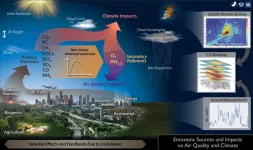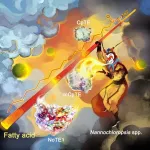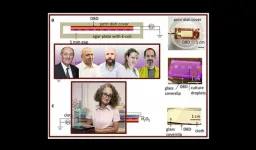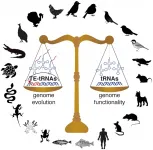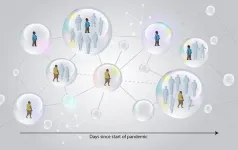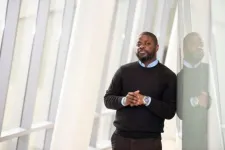"Science is having challenges in terms of getting the general public to support it and to understand its value, and outreach is one of the best ways by which we can change the dialogue and make progress," said José Dinneny, an associate professor of biology in Stanford University's School of Humanities and Sciences.
Concerned that scientists and non-scientists are growing farther apart, Dinneny and collaborators at several institutions have put together a white paper, published April 13 in Plant Direct, outlining the challenges of scientific outreach and how to improve it.
Dinneny and Ying Sun, co-author of the paper and former graduate student in the Dinneny lab, spoke with Stanford News about their guide and the realities of what it takes to produce effective science outreach.
Why are you concerned about outreach?
Dinneny: I don't think anyone could have lived through the last few years without thinking about the trust that comes from respectful communication, and how that's been tarnished. There is a need to reboot the dialogue about science and why it's valuable to society, and I think Stanford and members of this community could be leaders in this area.
Sun: We need to engage people about the importance of science at all levels of education. It's not just about hooking someone for a moment. It's about bringing more people into the academic pipeline and making STEM accessible and welcoming to everyone, so people can develop a lifelong fascination about the world they live in.
What science outreach challenges are you addressing in this guide?
Dinneny: A lot of faculty have great ideas and ambitions to help people through outreach. But how does one translate these good intentions into actual programs, and how do you know if you've actually made a positive impact or not?
We give examples of successful science outreach and outreach platforms. [Jump to examples.] We have a section dedicated to funding, which can come from different sources depending on the stage of development and scale of the outreach activity. We also encourage people to share data about their outreach and assessment of how well it accomplished what they set out to do. There's a lot of competition in science, but for outreach, we should all be working towards the same goal: to introduce people to the joy and wonder of discovery.
Sun: My contribution to the guide focused on mentorship and how to find belonging as an individual from a non-traditional scientific background. Once people are interested in pursuing science, we need to establish ways of supporting them so they can succeed and thrive.
The academic process can be really hard, especially for underrepresented and first-generation students, and we often expect too much from students. Writer and biochemist Beronda Montgomery described it this way: if a plant is wilted, you don't ask what's wrong with the plant, you ask what's wrong with the environment. That's why we emphasize in the paper how important it is to consider context when designing an outreach activity. Both the educational context and the unique perspective of the person being engaged matter a lot.
What are some of your favorite examples of outreach? Dinneny: One is the Be a Scientist program, which was conceived by a faculty member at UC Berkeley, Mary Wildermuth. She saw that explaining what scientists actually do is often left to college-level education and worked with the local school district to create Be a Scientist to address this deficit. In the Be a Scientist program, middle school students design experiments - they choose their own topic, come up with a testable hypothesis and figure out the control, the observations and the predictions of the results. Not only does this program help students see the basic steps of being a scientist, but it presents them with a way of approaching life.
Another example of outreach that I really like is the Taproot podcast, hosted by Liz Haswell and Ivan Baxter. They interview scientists about their research programs and get the behind-the-scenes story of certain papers, but they also discuss real personal issues that scientists have in terms of diversity, equity, inclusion and mental health challenges. Through these kinds of conversations, the general public can develop an understanding of scientists as real people, and we can normalize the struggles we're all experiencing.
What are you hoping to achieve by publishing this guide?
Dinneny: At the level of an individual, my hope is that this document will be a guide for new faculty, graduate students, postdocs and undergraduates to help them navigate the creation of an outreach program.
At the level of the university, I wonder if we can work towards a situation where faculty are not only evaluated for the basic research that they do but also how they're engaging with society to communicate the importance of that work. To a large extent, research is funded by taxpayer dollars, and so we should see value in communicating the importance of our science to the community that supports it.
At the level of scientific societies or organizations that promote science, I'm hoping that this document might encourage them to reinvigorate their approach to outreach. Do students, postdocs and faculty have opportunities to talk about their work in outreach just as they do their science? How is excellence in outreach rewarded? One of the most important functions of a scientific society should be to provide its members with the tools to more effectively connect with the broader public.
Although this paper applies to science outreach generally, there is some focus on plant science. Why is outreach about plant science important?
Sun: Growing up in Las Vegas, I never really thought about plants. There was a lot of food at the buffets, but I never really realized where my food came from. When you lose touch with plants, you lose touch with nature and the environment. And that influences important decisions about your own health and your impact on the environment.
Dinneny: To most people, plants aren't as immediately engaging as their animal cousins. They don't seem as complex because they lack brains. But most of the challenges that our society faces over the next 50 years relate to processes that plants perform: producing food, creating sustainable energy, sequestering carbon dioxide from the atmosphere and storing it in the soil.
One of the things that we propose in the manuscript is a reevaluation of the importance that plant science plays in the undergraduate curriculum, by acknowledging that plants are a fundamental part of our planet and that their biology is important, and making sure we have faculty who can support that scholarship.
We also need to help people see plant science as a viable career option. The agricultural field of the future - with drones and robots and CRISPR gene editing - is going to look very different than agriculture of the past. That's where outreach is so important. It's an opportunity to introduce students to professions where knowledge of plants is useful and influential.
INFORMATION:
Researchers from the following organizations and institutions are also co-authors: North American Arabidopsis Steering Committee; University of Massachusetts, Boston; Science Communication Lab; North Carolina State University; University of California, Davis; Iowa State University; Howard University; Danforth Plant Science Center; University of Arizona, Tucson; Washington University in St. Louis; Calstate University, Northridge; University of California, Berkeley; American Society of Plant Biologists; Spelman College; Plant Science Research Network; University of California, Los Angeles; University of Wisconsin-Madison; Indiana University and University of Indiana.
The work was funded by the National Science Foundation. Any opinions, findings, & conclusions or recommendations expressed in this event, or in resulting work, are those of the participants & do not necessarily reflect the views of the NSF.
